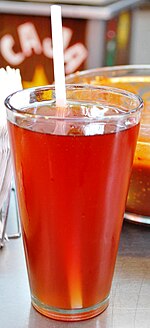 | |
| Course | Beverage |
|---|---|
| Place of origin | Mexico |
| Serving temperature | cold |
| Main ingredients | pineapple, piloncillo |
| Variations | added beer and cinnamon |
Tepache is a fermented beverage made from the peel and the rind of pineapples, and is sweetened either with piloncillo or brown sugar. It is sometimes seasoned with chili powder and served cold. Tepache is usually sold as a chilled drink by street vendors in Mexico, stored in barrels to expedite the fermentation process. It is served either in a clay mug or in a clear plastic bag with a straw inserted for easier travel. In the U.S., it is sold in juice bars or traditional Mexican restaurants within Mexican American communities of the Southwestern United States.
The fermentation process for making tepache is simple and quick, making it a drink readily produced at home. Though tepache is fermented for several days, the resulting drink does not contain much alcohol. The fermentation process relies on naturally occurring yeast and bacteria present on the pineapple peels and in the environment. The sugar serves as a nutrient source for these microbes, which produce lactic acid and carbon dioxide, contributing to tepache's slight effervescence and tart flavor.
Tepache is fermented by different microorganisms. Bacteria, such as Lactobacillus pentosus, L. paracasei, L. plantarum, L. lactis and yeast from the genus Saccharomyces have been found in tepache.[1] For optimal fermentation, it is recommended to use unrefined sugar such as piloncillo, which enhances the flavor and color of the drink. Tap water should be filtered to remove chlorine, which can inhibit the fermentation process. In Mexican culinary practice, the alcoholic content of tepache may be increased with a small amount of beer.
- ^ Ligenza, Alicja; Jakubczyk, Karolina Patrycja; Kochman, Joanna; Janda, Katarzyna (2021-09-27). "Health-promoting potential and microbial composition of fermented drink tepache". Medycyna Ogólna i Nauki o Zdrowiu (in Polish). 27 (3): 272–276. doi:10.26444/monz/138713. ISSN 2083-4543.